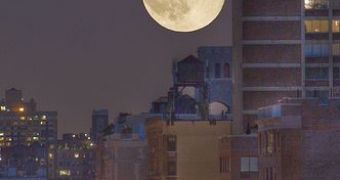Today the moon will reach full phase and it will actually be the smallest full moon of the year, as 13 hours after being officially full, it will be at the farthest point from Earth in its orbit.
The moon's apogee - the point in its orbit farthest from Earth, is at a distance of 252,518 miles (406,389 km), so the moon's apparent angular size tonight will be at minimum for 2010.
Even though the difference in size is 12.3 percent less compared to the full moon in January that nearly approached the moon's perigee – the closest point in its orbit relative to Earth, the casual viewer might not even see the difference.
Tonight might not be the best time to observe the moon as it will be at its brightest and it will appear one-dimensional to whoever looks at it.
Moon passionate can study it when it is at or just past first-quarter and last-quarter phases, that's when the best views of the landscape right along the terminator (the fine line between the illuminated and the shaded part of the moon), are visible.
Also, half moon gives a more comfortable view to the eye than a full moon and even if using a small optical power telescope of just a good pair or binoculars, most details on its surface are visible.
The lunar disk was at first-quarter, phase exactly 50 percent illuminated, on Monday, August 16 at 8:14 GMT (2:14 pm EDT), and lunar mountains became visible due to the light of the sun coming from the right.
Half moon is not half as bright as a full moon, in spite of what we may think, as the moon is heavily shadowed even on its illuminated half, and it is not until 2.4 days before being full, that the moon is actually half as bright.
The most common representation of the moon is a thin crescent or full, half moons are less frequent and gibbous moons are very rare.
A gibbous moon is the moon between half and full, and the term comes from the Latin word “gibbus” which means “hump”.
The gibbous moon is the most seen phase as it occurs for the half month between the first and the last quarter, and it is visible in the sky for more than half the night, SPACE.com reports.

 14 DAY TRIAL //
14 DAY TRIAL //